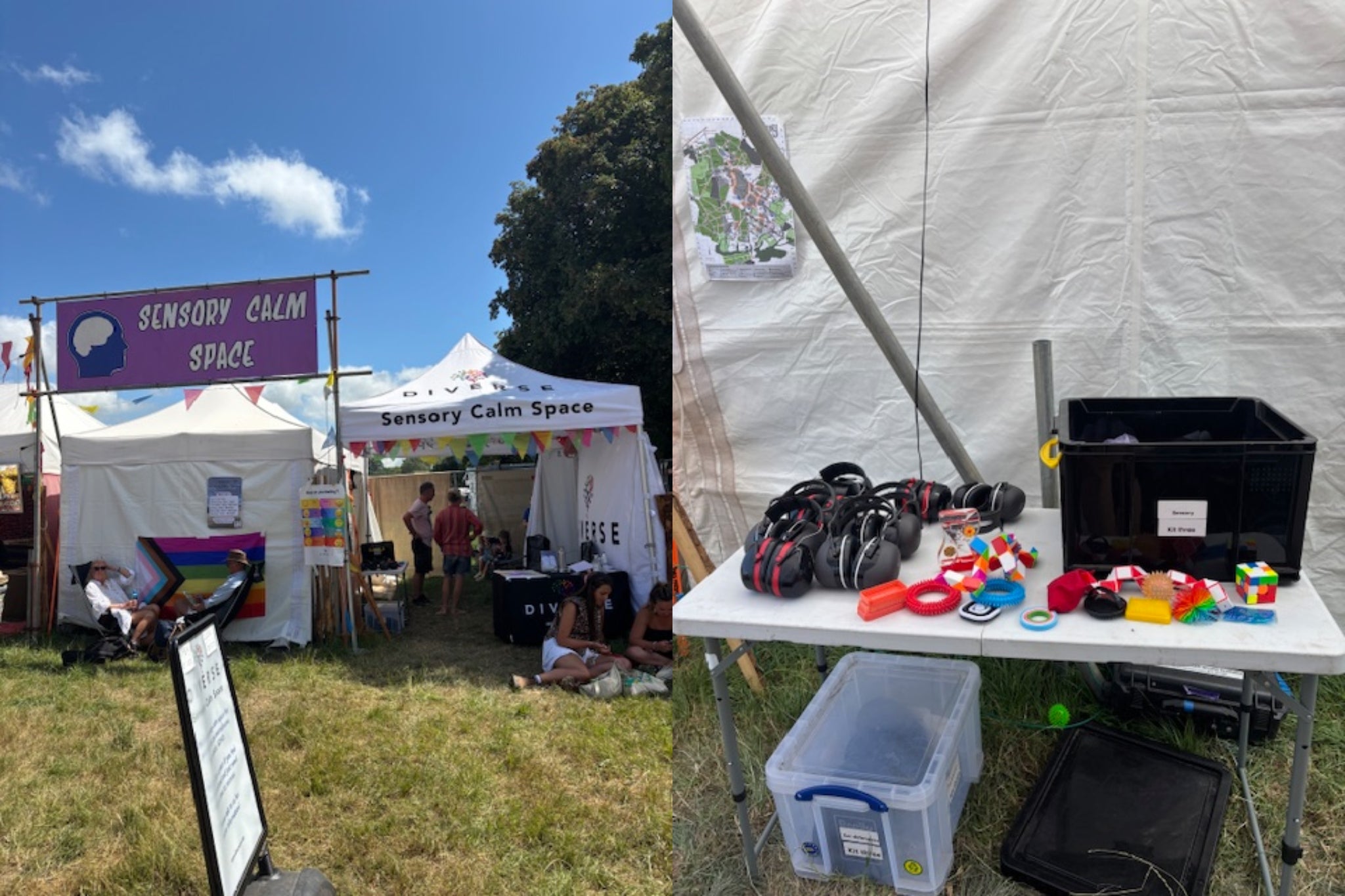
Nobody comes to Glastonbury to relax. With 200,000 people on site, countless musical acts to see, and miles of farmland to traipse across, it couldn’t be a less conducive atmosphere for calming your nervous system.
The music is loud and everything else somehow feels even louder. Most of us dive in headfirst, thinking we’ll just keep calm and carry on until the dreaded Monday morning return. Of course, for the neurodivergent, it’s not quite so simple.
Thankfully, all that is changing. Because this year, relaxation seems to be a priority for Glastonbury, with a new site dedicated to fostering those quieter moments. Nearby Shangri-La is Dragon’s Tail, which features a 40 metre dragon sculpture created by stained glass artist Edgar Phillips, a 170 metre mural, and a chilled out bar area. The space is all about encouraging people to take time out from the madness. Glastonbury has also partnered with earplug company Loop, encouraging festivalgoers to look after their hearing by wearing the sound-reducing earplugs (which are available to buy on site) when near speakers. We’ve spotted plenty of people wearing them.
On top of this, there’s another new initiative helping Glastonbury-goers wind down. Introducing Sensory Calm Space (SCS). Run by the charity Diverse UK and with multiple sites across the festival, the SCS provides those in need of a break with a safe, quiet, cool space to wind down. Guests are invited into a dark, tented area where they can put on a pair of noise-cancelling headphones and de-stress with a toy of their choice (think head massagers, stress balls, and textured blocks). From there, you can settle into a bean bag or chair, and stay for as long or as little as you like. There is peace, quiet and, wait for it, aircon – an unbelievably valuable commodity on a site with famously little shade. “We don’t advertise that too widely in this heat,” says Josh, who helps run the SCS near the Pyramid Stage.
Designed specifically for neurodivergent people, the spaces use lighting, sound and texture to lower the brain frequencies so visitors can calm down before venturing back out to enjoy the rest of the festival. That said, anyone feeling a little overwhelmed can visit an SCS – and they often do. “We get all sorts of people visiting,” adds Josh, explaining how most of their neurodivergent visitors are informed about the SCS in advance and make a beeline as soon as they arrive. Other people, he says, just walk past and decide to come in: “They always leave feeling so much better; sometimes they fall asleep.”
Run entirely by volunteers, the service has become increasingly popular among all kinds of festivalgoers ever since it was introduced in 2022 with just one space near the West Holts stage. Now, there are five dotted around the festival, including one solely for crew. Most are open from 10am till midnight, though there is one near Shangri-La in the festival’s newly launched Dragon Tail chill-out area that is open till 4am.
These services are incredibly popular: on Friday, 150 people visited the West Holts SCS, which has space for 15-20 people. Volunteers estimate that around 1,000 people in total will visit the spaces over the course of the weekend. The one I visit has a queue, with people of all ages going in, including some children, who can only use the service when accompanied by an adult. Also in the mix are a few very sunburnt people desperately searching for some shaded respite.
“I’m neurodivergent myself and I used to have to leave events like this or I’d just get lost,” says Diverse UK’s Harry Jones. “A lot of people who come here say they wouldn’t be able to attend if this wasn’t here.” But Jones is aware that an SCS can provide ample benefits for anyone. “It’s got a lot more popular beyond the neurodivergent community because there’s a lot of people needing to reset at events like this that are so overwhelming on our senses. We also know that since the pandemic, there’s been a great rise in anxiety, so it helps people to know there are provisions in places that they’re entitled to and can use.”

Occasionally, people will visit an SCS with deeper emotional or psychological issues. They’re often passed onto welfare. Of course, as is par for the course at any festival, sometimes people visit when they’ve taken drugs. “At Silver Hayes [a dance music area] we had a guy who’d taken too many mushrooms and he needed to reset,” says Jones. “We ended up taking him to welfare because he was disturbing the other guests, but once he’d stabilised, he came back.”
I spent about 15 minutes in the SCS and can confirm that it is a game-changing experience, not least because of the aircon, which successfully recalibrates my body temperature and tempers the lingering feeling I’m about to faint (it’s somewhere around 27 degrees today).
With a small blue spiky toy in my palm and a pair of noise-cancelling headphones over my ears, I feel instantly calmer and more in tune with my mind and body, an experience that is all too rare at a festival. It is incredible to just sit silently for a while and re-centre myself in a quiet space away from the crowds.
In all honesty, I could stay for hours. But there is music to see and people to meet, but I’ll certainly feel a lot better doing all of that, having taken the time to decompress. I can’t recommend it highly enough. Maybe Glastonbury can be relaxing after all.







